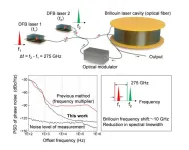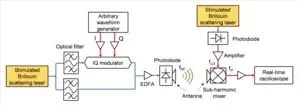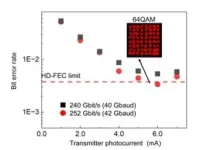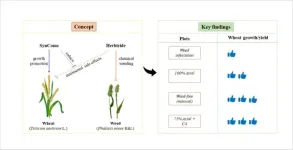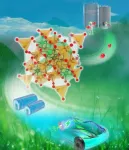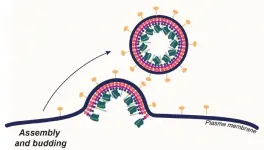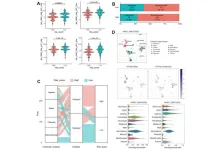Photonics-based wireless link breaks speed records for data transmission
Researchers from Osaka University and IMRA AMERICA use a stimulated Brillouin scattering laser to generate the signals needed by sub-terahertz transmitters and receivers, enabling super-high communication speeds for our tablets and phones
2024-02-01
(Press-News.org)
Osaka, Japan – From coffee-shop customers who connect their laptop to the local Wi-Fi network to remote weather monitoring stations in the Antarctic, wireless communication is an essential part of modern life. Researchers worldwide are currently working on the next evolution of communication networks, called “beyond 5G” or 6G networks. To enable the near-instantaneous communication needed for applications like augmented reality or the remote control of surgical robots, ultra-high data speeds will be needed on wireless channels. In a study published recently in IEICE Electronics Express, researchers from Osaka University and IMRA AMERICA have found a way to increase these data speeds by reducing the noise in the system through lasers.
To pack in large amounts of data and keep responses fast, the sub-terahertz band, which extends from 100 GHz to 300 GHz, will be used by 6G transmitters and receivers. A sophisticated approach called “multi-level signal modulation” is used to further increase the data transmission rate of these wireless links. However, when operating at the top end of these extremely high frequencies, multi-level signal modulation becomes highly sensitive to noise. To work well, it relies on precise reference signals, and when these signals begin to shift forward and backward in time (a phenomenon called “phase noise”), the performance of multi-level signal modulation drops.
“This problem has limited 300-GHz communications so far,” says Keisuke Maekawa, lead author of the study. “However, we found that at high frequencies, a signal generator based on a photonic device had much less phase noise than a conventional electrical signal generator.”
Specifically, the team used a stimulated Brillouin scattering laser, which employs interactions between sound and light waves, to generate a precise signal. They then set up a 300 GHz-band wireless communication system that employs the laser-based signal generator in both the transmitter and receiver. The system also used on-line digital signal processing (DSP) to demodulate the signals in the receiver and increase the data rate.
“Our team achieved a single-channel transmission rate of 240 gigabits per second,” says Tadao Nagatsuma, PI of the project. “This is the highest transmission rate obtained so far in the world using on-line DSP.”
As 5G spreads across the globe, researchers are working hard to develop the technology that will be needed for 6G, and the results of this study are a significant step toward 300GHz-band wireless communication. The researchers anticipate that with multiplexing techniques (where more than one channel can be used) and more sensitive receivers, the data rate can be increased to 1 terabit per second, ushering in a new era of near-instantaneous global communication.
###
The article, “Single-channel 240-Gbit/s sub-THz wireless communications using ultra-low phase noise receiver,” was published in IEICE Electronics Express at DOI: https://doi.org/10.1587/elex.20.20230584
About Osaka University
Osaka University was founded in 1931 as one of the seven imperial universities of Japan and is now one of Japan's leading comprehensive universities with a broad disciplinary spectrum. This strength is coupled with a singular drive for innovation that extends throughout the scientific process, from fundamental research to the creation of applied technology with positive economic impacts. Its commitment to innovation has been recognized in Japan and around the world, being named Japan's most innovative university in 2015 (Reuters 2015 Top 100) and one of the most innovative institutions in the world in 2017 (Innovative Universities and the Nature Index Innovation 2017). Now, Osaka University is leveraging its role as a Designated National University Corporation selected by the Ministry of Education, Culture, Sports, Science and Technology to contribute to innovation for human welfare, sustainable development of society, and social transformation.
Website: https://resou.osaka-u.ac.jp/en
END
ELSE PRESS RELEASES FROM THIS DATE:
2024-02-01
Synthetic microbial communities (SynComs) are emerging as powerful allies in the battle against weeds. These carefully crafted assemblies of microorganisms, such as compatible Pseudomonas strains, are designed to target specific weeds while promoting crop growth. The application of herbicides with SynComs will be essential to understand their synergistic effects for controlling weed and promoting wheat growth, so that provides a sustainable and eco-friendly weed control strategy. By harnessing the collective strength of Pseudomonas SynComs, this research brings us ...
2024-02-01
Supercapacitors, also known as ultracapacitors or electric double-layer capacitors (EDLCs), are advanced energy storage devices with unique characteristics. Unlike traditional batteries, supercapacitors store energy through the electrostatic separation of charges at the interface between an electrolyte and a high-surface-area electrode. This mechanism allows for rapid energy storage and release, enabling supercapacitors to deliver high power bursts and exhibit exceptional cycle life.
Supercapacitors play a pivotal role in the realm of renewable energy and environmental conservation. In the context of renewable energy, supercapacitors serve as crucial components ...
2024-02-01
Most approved gene therapies today, including those involving CRISPR-Cas9, work their magic on cells removed from the body, after which the edited cells are returned to the patient.
This technique is ideal for targeting blood cells and is currently the method employed in newly approved CRISPR gene therapies for blood diseases like sickle cell anemia, in which edited blood cells are reinfused in patients after their bone marrow has been destroyed by chemotherapy.
A new, precision-targeted delivery method for CRISPR-Cas9, published Jan. 11 in the journal Nature Biotechnology, enables gene editing on very specific subsets of cells while still in the body — ...
2024-02-01
Study of 1.5 million people over the age of 16 in England, including nearly 8,000 transgender people, finds a higher proportion of transgender adults report having a long-term mental health condition than cisgender adults.
Additionally, those with a gender identity other than cisgender male or cisgender female were more likely to report their mental health needs were unmet at their last general practice appointment.
Authors call for the NHS to become more gender-inclusive, including by introducing better training for health-care professionals to improve their ability ...
2024-02-01
A University of Tennessee Extension specialist has been selected to help lead a new national effort to connect resources and individuals in the quickly evolving food and agriculture career sector.
Clint Cummings, Extension specialist in the Department of Family and Consumer Sciences, will serve as the National Network Lead and Regional Network Coordinator for the Southern Region for the new AgriProspects Workforce Development Network project. This project is being conducted through the Extension Foundation in collaboration with the ECOP (Extension Committee on Organization and Policy) Economic & Workforce Development Program Action Team and NECIW (National Extension ...
2024-02-01
Pacific Island governments are increasingly imposing taxes on unhealthy foods as they battle a non-communicable disease crisis, a New Zealand study shows.
The research, led by the University of Otago, Wellington, found that since 2000, a quarter of the 22 Pacific Island countries and territories studied had introduced taxes targeting unhealthy foods, a strategy in line with recommendations from the World Health Organization.
The study of food taxation policies over the 20 years to 2020 is published in the international journal Public Health Nutrition.
Senior Research Fellow, ...
2024-01-31
January 31, 2024
Climate Change Threatens Older Elephants Most, Jeopardizing African Elephants’ Future
New study from UMass Amherst and Wildlife Conservation Society finds that continuing international cooperation, community involvement most important in ensuring elephants’ survival
AMHERST, Mass. – A collaborative team of researchers from the University of Massachusetts Amherst and the Wildlife Conservation Society (WCS), which runs the world’s largest field conservation program, has conducted first-of-its kind research into how global climate change affects African elephants. The work, published recently in PLOS Sustainability and Transformation, ...
2024-01-31
“These findings provided evidence for the role of senescence in the tumor microenvironment [...]”
BUFFALO, NY- January 31, 2024 – A new research paper was published on the cover of Aging (listed by MEDLINE/PubMed as "Aging (Albany NY)" and "Aging-US" by Web of Science) Volume 16, Issue 2, entitled, “Prognostic significance of senescence-related tumor microenvironment genes in head and neck squamous cell carcinoma.”
The impact of the senescence related microenvironment on cancer prognosis and therapeutic response remains poorly understood. In this new study, researchers Young Chan Lee, Yonghyun Nam, Minjeong Kim, ...
2024-01-31
Andrew Muhammad, professor and Blasingame Chair of Excellence in Agricultural Policy at the University of Tennessee Institute of Agriculture, has been elected president of the Southern Agricultural Economics Association. The newly elected president will be recognized at the Association’s upcoming annual meeting in Atlanta, Georgia, from February 3-6.
“We are excited for Dr. Muhammad in this important leadership role,” says Bill Johnson, interim department head for UT’s Department of Agricultural and Resource Economics. “His previous experience with SAEA and his global perspective on agriculture ...
2024-01-31
Rates of kidney stones are on the rise in the United States and around the world. Type 2 diabetes is associated with increased risk of kidney stones, but some forms of treatment for this condition may also have the benefit of lowering risk of kidney stones. In a study led by investigators from Mass General Brigham, researchers found that there was an association between the use of sodium-glucose contratransporter 2 (SGLT2) inhibitors and a lower risk of developing kidney stones. Their findings are reported in JAMA Internal Medicine.
Researchers from Brigham and Women’s Hospital and Massachusetts ...
LAST 30 PRESS RELEASES:
[Press-News.org] Photonics-based wireless link breaks speed records for data transmission
Researchers from Osaka University and IMRA AMERICA use a stimulated Brillouin scattering laser to generate the signals needed by sub-terahertz transmitters and receivers, enabling super-high communication speeds for our tablets and phones
